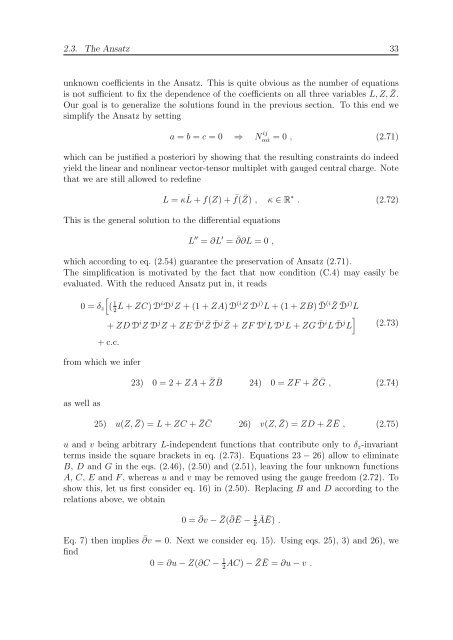N=2 Supersymmetric Gauge Theories with Nonpolynomial Interactions
N=2 Supersymmetric Gauge Theories with Nonpolynomial Interactions
N=2 Supersymmetric Gauge Theories with Nonpolynomial Interactions
You also want an ePaper? Increase the reach of your titles
YUMPU automatically turns print PDFs into web optimized ePapers that Google loves.
2.3. The Ansatz 33<br />
unknown coefficients in the Ansatz. This is quite obvious as the number of equations<br />
is not sufficient to fix the dependence of the coefficients on all three variables L, Z, ¯ Z.<br />
Our goal is to generalize the solutions found in the previous section. To this end we<br />
simplify the Ansatz by setting<br />
a = b = c = 0 ⇒ N ij<br />
α ˙α = 0 , (2.71)<br />
which can be justified a posteriori by showing that the resulting constraints do indeed<br />
yield the linear and nonlinear vector-tensor multiplet <strong>with</strong> gauged central charge. Note<br />
that we are still allowed to redefine<br />
L = κ ˆ L + f(Z) + ¯ f( ¯ Z) , κ ∈ R ∗ . (2.72)<br />
This is the general solution to the differential equations<br />
L ′′ = ∂L ′ = ¯ ∂∂L = 0 ,<br />
which according to eq. (2.54) guarantee the preservation of Ansatz (2.71).<br />
The simplification is motivated by the fact that now condition (C.4) may easily be<br />
evaluated. With the reduced Ansatz put in, it reads<br />
<br />
0 = δz ( 1<br />
2L + ZC) DiD j Z + (1 + ZA) D (i Z D j) L + (1 + ZB) ¯ D (i Z¯ D¯ j)<br />
L<br />
+ ZD D i Z D j Z + ZE ¯ D i <br />
Z¯ D¯ j<br />
Z ¯ i j<br />
+ ZF D L D L + ZG D¯ i<br />
L D¯ j<br />
L (2.73)<br />
+ c.c.<br />
from which we infer<br />
as well as<br />
23) 0 = 2 + ZA + ¯ Z ¯ B 24) 0 = ZF + ¯ Z ¯ G , (2.74)<br />
25) u(Z, ¯ Z) = L + ZC + ¯ Z ¯ C 26) v(Z, ¯ Z) = ZD + ¯ ZĒ , (2.75)<br />
u and v being arbitrary L-independent functions that contribute only to δz-invariant<br />
terms inside the square brackets in eq. (2.73). Equations 23 − 26) allow to eliminate<br />
B, D and G in the eqs. (2.46), (2.50) and (2.51), leaving the four unknown functions<br />
A, C, E and F , whereas u and v may be removed using the gauge freedom (2.72). To<br />
show this, let us first consider eq. 16) in (2.50). Replacing B and D according to the<br />
relations above, we obtain<br />
0 = ¯ ∂v − ¯ Z( ¯ ∂<br />
1 Ē − ĀĒ) . 2<br />
Eq. 7) then implies ¯ ∂v = 0. Next we consider eq. 15). Using eqs. 25), 3) and 26), we<br />
find<br />
0 = ∂u − Z(∂C − 1<br />
2AC) − ¯ ZĒ = ∂u − v .

















